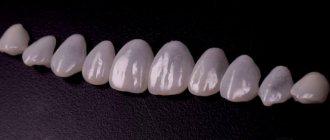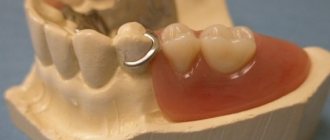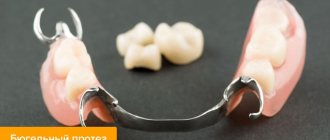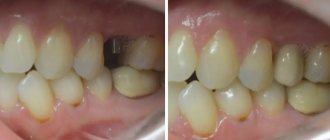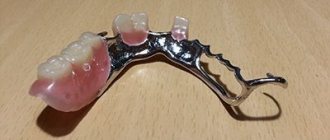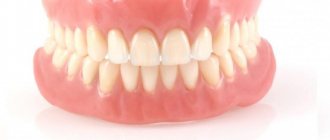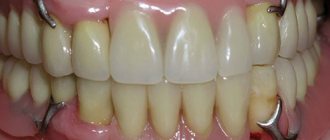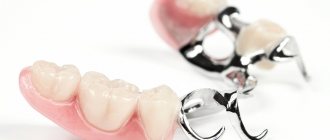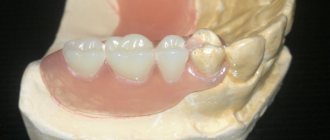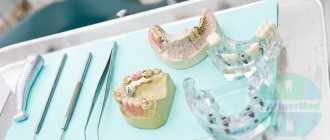This is one of the types of removable dentures in which the base (that is, the part on which the artificial teeth and support-retaining elements are located) is made of metal, which can significantly reduce the volume that this very denture occupies in the oral cavity.
On the lower jaw, the base of the clasp denture consists of a thin metal arch and saddle-shaped parts (artificial teeth are located there).
On the upper jaw, these elements are supplemented by a thin palatal bridge, which connects the saddle-shaped parts of the prosthesis and helps distribute the chewing load more evenly.
The indication for the use of clasps is partial loss of teeth, but in the initial stage of damage to the dentition, when there is still a sufficient number of them in it, and the condition of which allows for good fixation of the prosthesis, as well as to avoid functional overload of the supporting teeth.
If the destruction of the dentition goes far and there are few of them left, then this factor is a contraindication to the use of a clasp denture, since the likelihood of overloading the supporting teeth becomes obvious.
Also, the use of clasps is impossible in the presence of extensive terminal defects of the dentition, combined with the loss of fangs, since there is a danger of overloading the remaining teeth.
Clasp dentures can be fixed in the oral cavity using clasps (“hooks”), locks or telescopic crowns.
Indications
The main indication for installing a clasp denture with a splinting effect is the absence of several teeth in the presence of loose or unstable areas in the jaw structure. The cause of the development of pathologies can be either maxillofacial trauma or degenerative-inflammatory processes in the oral cavity. The second option is the most common. Thus, periodontal damage with receding gums and exposure of the roots leads to loosening of the teeth, while a splinting prosthesis reliably fixes the crowns and does not put pressure on the soft tissues, allowing them to recover. This increases the effectiveness of complex treatment of periodontal disease and periodontitis.
Thus, splinting clasp dentures simultaneously solve several dental problems:
- stabilize mobile teeth in the correct position;
- competently redistribute the chewing load on the gums;
- restore the integrity of the row and the aesthetics of the smile line.
On a note!
Periodontium is a complex of tissues located around the tooth. It includes the gums, alveolar walls, ligaments, and bone tissue. When these structures are destroyed, the tooth root gradually loses support and the tooth begins to wobble.
Contraindications to the installation of splinting clasp dentures:
- Extreme degree of periodontal destruction with a high risk of tooth loss. In this case, it is difficult to take impressions without causing loss.
- The patient’s inability to maintain healthy oral hygiene – when wearing dentures, bacterial plaque accumulates especially actively around the crowns, provoking the carious process.
- Complete absence of teeth (complete edentia) - installation of clasp structures requires the presence of at least one supporting tooth.
- An allergic reaction to anesthesia or materials of construction - metal alloys, plastics, acrylic compounds may cause irritation or discomfort in some patients.
Splinting clasp dentures: before and after photos
A splinting clasp prosthesis performs two functions at once: it helps preserve loose teeth and replaces lost ones. An orthopedic device is made individually for each patient, taking into account the condition of mobile teeth and the number of lost teeth, characteristics of the bite and jaw structure, age, as well as some other factors.
Peculiarities
The German word “byugel” is translated as “arc,” which reflects the main feature of the design: artificial crowns are attached to a curved base made of medical alloy. When put on, the denture fits tightly to the gum due to metal fasteners, which provide reliable fixation without the risk of losing the false jaw. Moreover, in order to remove the prosthesis on your own, you will have to make considerable efforts.
Unlike plate-based removable “brothers”, the prosthesis turns out to be more convenient: the base for the lower jaw is not so massive, and the upper structure is devoid of an inconvenient solid plate that completely covers the palate - it is replaced by a thin bridge that does not create inconvenience during operation. In addition, the clasps and the base itself do not compress the teeth from the sides, which allows complex treatment of periodontal tissues to be carried out without interference.
Types of fastenings for splinting prostheses:
- multi-link clasps (the most common method of fixation);
- occlusal pads;
- claw clamps.
All of them reliably fasten the teeth together, eliminating their mobility, and at the same time contribute to better redistribution of the load along the gingival arch, do not irritate the tissue and prevent gum atrophy.
Rules for caring for artificial teeth
In order for the splinting clasp device to serve for a long time and maintain its aesthetic appearance, it is important to properly care for it. You can minimize the risk of frequent breakdowns if you follow simple rules:
Clean the device twice a day with a brush and paste that does not contain large abrasive particles;- rinse your mouth after each meal with warm water or an antibacterial dental rinse;
- clean the system every evening with a special solution;
- Avoid eating too hard foods and never chew on foreign hard objects;
- Visit the dentist twice a year so that he can assess the condition of the prosthesis and correct its location in the oral cavity.
If your denture fails, you should not attempt to repair it yourself. The most reasonable decision in such a situation is to contact your doctor. He will examine the breakdown and, if it can be corrected, will transfer the device to a dental technician. If it turns out that the device needs to be replaced with a new one, he will take care of this issue.
Stages of prosthetics
At the preparation stage, the patient undergoes an X-ray examination. They evaluate the condition of hard and soft tissues, the structure of the bite, the functioning of the jaw joints, the presence of inflammation, the percentage of destruction of individual structures, and check the general condition of the oral cavity. Immediately before the start of orthopedic treatment, foci of caries are eliminated, professional cleaning is carried out to remove soft and hard deposits in the neck and root area, and curettage is performed if necessary.
Attention!
In the case of high tooth mobility, periodontal pockets are cleaned after the installation of dentures - in order to avoid even further loosening.
The production and installation of splinting clasp dentures takes place in 4 stages:
- Taking impressions – in the classical way using plastic materials or using digital technologies of 3D scanning of the oral cavity. If there is a high degree of tooth mobility, the second option is preferable - it eliminates the possibility of a mobile tooth falling out.
- Creation of a prosthesis - using impressions in a dental laboratory, a copy of the patient’s jaw row is made, on the basis of which the technician forms the base and coronal part of the working structure.
- Fitting and modification - the finished prosthesis is tried on and, if necessary, adjusted, eliminating inconsistencies.
- Final installation is performed by an orthopedic dentist after all roughness of the product has been eliminated.
During operation, the patient can independently remove and install the structure. However, this should not be done unless absolutely necessary - frequent pressure on the tight fastening of the prosthesis can aggravate the mobility of loose crowns. The prosthesis is removed once every 2–3 weeks for preventative cleaning. The rest of the time, hygienic care of the device is carried out directly in the oral cavity with a special brush and paste.
On a note!
In addition to convenient removable structures, there are non-removable medical devices that can be installed and removed only in a dental office. As a rule, they are used for temporary course treatment.
Manufacturing
To install a denture, you need to visit the dentist several times. At the first stage, the doctor examines the patient and determines what dental pathologies he has. Based on the information received, he creates a clear and effective treatment plan. Takes necessary measurements, prepares supporting elements.
The second stage is making the impression tray. The client is asked to come in for impressions to be taken, which are sent to the dental laboratory. Based on them, a model is made from wax and plaster, and a base with a frame for crowns is cast.
The next stage is the first fitting of the prosthesis. During this process, detected inaccuracies are eliminated. Only after this is the wax arc replaced with a plastic analogue, and the base is ground and polished.
On the appointed day, the clasp splinting device is installed on the patient and adjusted. The installation procedure is quite simple and takes very little time. The doctor tells the client in detail how to properly remove and put on the mechanism independently, and how to care for it.
Advantages
Positive aspects of clasp dentures:
- strong fixation – among removable structures they are the most reliable;
- convenient configuration – provide a more uniform distribution of the load on the soft tissue of the gums due to the presence of supporting teeth;
- comfortable to wear - a relatively small base does not cover the palate, does not distort taste, does not impair diction and does not rub soft tissues;
- possibility of installation without grinding healthy teeth;
- long service life - with proper care it can last up to 10 years.
On a note!
A clasp prosthesis, as well as its plate analogue, can lead to gradual atrophy of bone tissue, however, due to optimal redistribution of the load, it develops 2–3 times slower than with any other types of removable structures
.
Distinctive features of clasp splinting developments
If we compare a splinting prosthesis with a conventional clasp prosthesis, it is usually more convenient to use. This is explained by the fact that its basis is smaller. It also does not cover the palate and leaves the tongue free. This means that neither diction nor a person’s taste sensations change.
It is important that splinting clasp systems do not cause atrophic changes in the gums and bone tissues of the jaw. Therefore, when wearing them for a long time, the patient does not experience any significant discomfort.
Materials for splinting structures
There are a number of requirements for splinting materials. They have to:
- firmly fixed
- do not injure surrounding tissues,
- do not deform over time,
- be hypoallergenic,
- have an aesthetic appearance,
- do not interfere with diction, eating and hygiene procedures.
Fiberglass and aramid threads meet these requirements. Due to their properties, these materials are widely used in dentistry.
Dentists on Rimskaya
Gneusheva Elena Viktorovna
Dentist-orthodontist, pediatric orthodontist
Experience: 20 years
★ For more than 13 years she worked at the Moscow State Medical University at the Department of Orthodontics and Children's Prosthetics, Ph.D.
Gorokhova Inga Vitalievna
Dentist-therapist
Experience: 14 years of total experience
★ Expertise in restorative dentistry to make your teeth shine
Konstantinov Oleg Nikolaevich
Dental surgeon
Experience: 25 years
★ Virtuoso of painless treatment. Patients fall asleep in the doctor's chair
Nikolaychuk Anna Vladimirovna
Chief physician, dentist-therapist
Experience: 13 years
★ Chief specialist in the treatment of toothache. Masterfully deals with problems quickly and permanently
Advantages and disadvantages
Among the advantages of splinting, several points are highlighted:
- Decreased mobility. Splinting prevents further loosening and loss of problem units.
- Load redistribution. Part of the chewing load will be taken by healthy teeth and splinting structures.
- Reducing the rate of bone tissue atrophy. This is achieved by stabilizing the teeth and reducing the range of their movement.
- Reducing bleeding gums. The processes of formation of periodontal pockets and exposure of the root parts of the tooth are slowed down.
- The appearance of the dentition improves. Splinting structures replace missing teeth. During the splinting process, the dentist can hide large interdental spaces and correct minor deviations.
The disadvantages of splinting include:
- discomfort experienced by patients during the period of adaptation to removable splinting structures,
- the need to depulpate and grind healthy teeth for some splinting methods
- possible complications after the procedure.
After this procedure, patients may eventually experience: pulpitis (inflammation of internal tissues), loosening of supporting teeth and exacerbation of the pathological process. As a rule, complications after splinting occur due to the fault of the dentist, so contact only experienced specialists.
Splinting with fiberglass and aramid threads
This splinting method can only be used on an intact dentition. Fiberglass and aramid bands are used to strengthen the front and side teeth. A small groove is made on the inside of the lower front teeth; its depth is only a few millimeters. The dentist inserts a splint into the resulting groove. It is a solid fiberglass tape or a woven aramid thread. Next, the furrow is sealed with light-curing materials. This splint usually combines from 4 to 6 teeth. In addition to movable units, stationary ones are also used under the splint so that they stabilize the resulting system and take on part of the chewing load. As a rule, fangs are used for these purposes.
For the upper front and lateral teeth, the technology is slightly different: when splinting the upper units, their front surface is used to create a groove, and on the lateral ones, the chewing surface is used. The splint is securely fixed, hardens and forms a block system from a section of the dentition. The chewing load is evenly distributed between all its elements. It extends the life of mobile teeth and slows down the process of bone tissue atrophy.
Visually, the splint is invisible and does not spoil your smile. To install it, you do not need to grind or remove nerves. During the procedure, the gum tissue is not injured. If necessary, the splint can be easily removed and the remaining furrow can be sealed. Thanks to its efficiency and reliability, the procedure has the most positive reviews.

